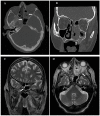Challenging Diagnosis of Invasive Sinus Aspergillosis Mimicking Gradenigo's Syndrome in an Elderly Patient with T-Cell Lymphoma
- PMID: 38247979
- PMCID: PMC10801611
- DOI: 10.3390/geriatrics9010004
Challenging Diagnosis of Invasive Sinus Aspergillosis Mimicking Gradenigo's Syndrome in an Elderly Patient with T-Cell Lymphoma
Abstract
(1) Background: Gradenigo's Syndrome (GS) is a rare complication of acute otitis media characterized by the triad of diplopia, otitis, and facial pain. The widespread use of antibiotics has significantly reduced its occurrence. (2) Case summary: We present the case of an elderly patient with T-cell lymphoma who developed neurological deficits resembling GS. The patient was ultimately diagnosed with invasive sinus aspergillosis. The diagnostic process was challenging due to the atypical clinical presentation and the lack of specific imaging findings. A biopsy was the most important test for clarifying the diagnosis. (3) Conclusions: The prognosis for this complication is extremely poor without surgery, and the patient died despite adequate antifungal coverage. Therefore, maintaining high clinical suspicion is paramount to avoid adverse outcomes in similar cases, particularly in the geriatric population, wherein this syndrome's occurrence may not be expected.
Keywords: T-cell lymphoma; elderly; fungal infection; immunosuppression; invasive aspergillosis.
Conflict of interest statement
The authors declare no conflict of interest.
Figures



Similar articles
-
Gradenigo's Syndrome With Septic Lateral Sinus Thrombosis.Cureus. 2023 Feb 9;15(2):e34797. doi: 10.7759/cureus.34797. eCollection 2023 Feb. Cureus. 2023. PMID: 36915831 Free PMC article.
-
Gradenigo's Syndrome: Beyond the Classical Triad of Diplopia, Facial Pain and Otorrhea.Case Rep Neurol. 2011 Feb 15;3(1):45-7. doi: 10.1159/000324179. Case Rep Neurol. 2011. PMID: 21490711 Free PMC article.
-
A Case of Gradenigo's Syndrome in an Elderly Patient.Cureus. 2024 Jun 24;16(6):e63062. doi: 10.7759/cureus.63062. eCollection 2024 Jun. Cureus. 2024. PMID: 39050326 Free PMC article.
-
The Forgotten Syndrome? Four Cases of Gradenigo's Syndrome and a Review of the Literature.Strabismus. 2016;24(1):21-7. doi: 10.3109/09273972.2015.1130067. Epub 2016 Mar 16. Strabismus. 2016. PMID: 26979620 Review.
-
Gradenigo's syndrome: is fusobacterium different? Two cases and review of the literature.Int J Pediatr Otorhinolaryngol. 2014 Jan;78(1):166-9. doi: 10.1016/j.ijporl.2013.11.004. Epub 2013 Nov 20. Int J Pediatr Otorhinolaryngol. 2014. PMID: 24315216 Review.
References
-
- Pedroso J.L., de Aquino C.C.H., Abrahão A., de Oliveira R.A., Pinto L.F., Bezerra M.L.E., Gonçalves Silva A.B., de Macedo F.D.B., de Melo Mendes A.V., Barsottini O.G.P. Gradenigo’s Syndrome: Beyond the Classical Triad of Diplopia, Facial Pain and Otorrhea. Case Rep. Neurol. 2011;3:45–47. doi: 10.1159/000324179. - DOI - PMC - PubMed
Publication types
LinkOut - more resources
Full Text Sources

